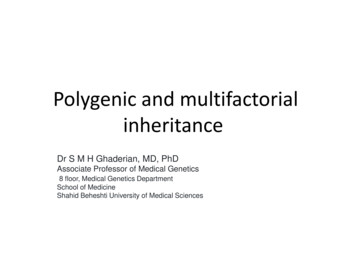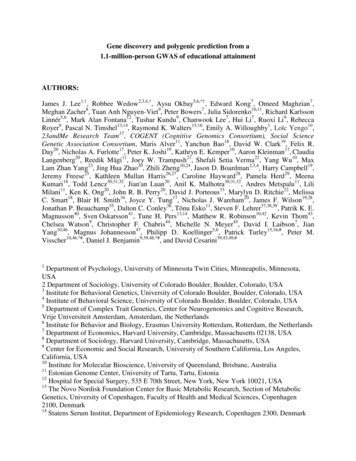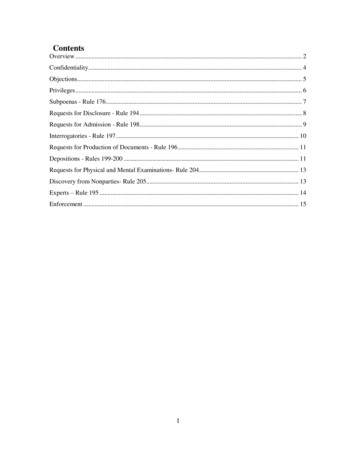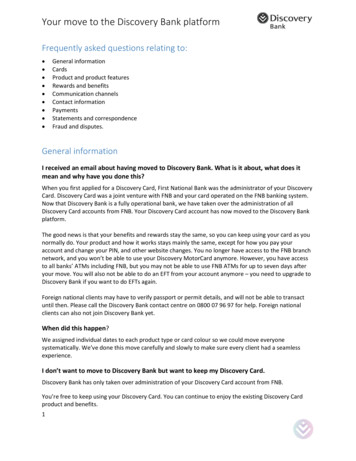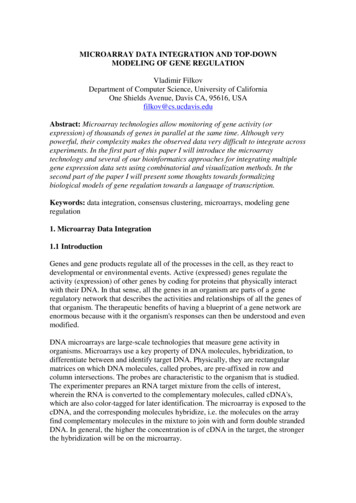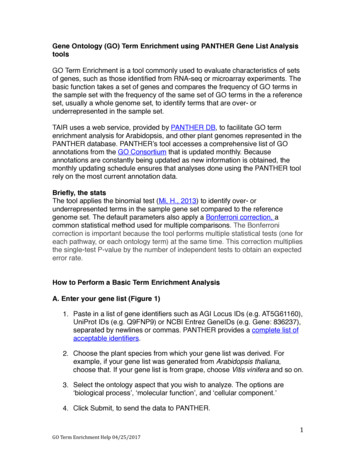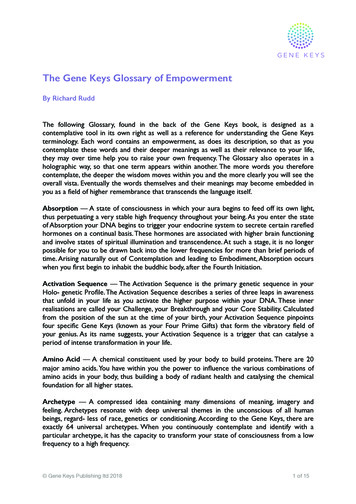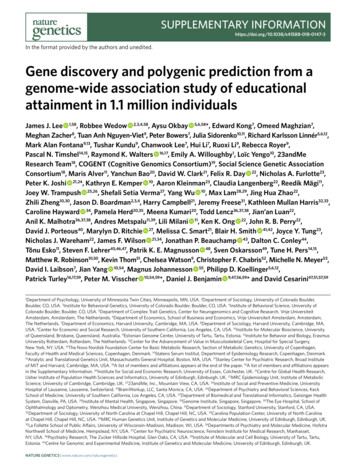
Transcription
ArticlesSUPPLEMENTARY -3In the format provided by the authors and unedited.Gene discovery and polygenic prediction from agenome-wide association study of educationalattainment in 1.1 million individualsJames J. Lee 1,58, Robbee Wedow 2,3,4,58, Aysu Okbay 5,6,58*, Edward Kong7, Omeed Maghzian7,Meghan Zacher8, Tuan Anh Nguyen-Viet9, Peter Bowers7, Julia Sidorenko10,11, Richard Karlsson Linnér5,6,12,Mark Alan Fontana9,13, Tushar Kundu9, Chanwook Lee7, Hui Li7, Ruoxi Li9, Rebecca Royer9,Pascal N. Timshel14,15, Raymond K. Walters 16,17, Emily A. Willoughby1, Loïc Yengo10, 23andMeResearch Team18, COGENT (Cognitive Genomics Consortium)19, Social Science Genetic AssociationConsortium18, Maris Alver11, Yanchun Bao20, David W. Clark21, Felix R. Day 22, Nicholas A. Furlotte23,Peter K. Joshi 21,24, Kathryn E. Kemper 10, Aaron Kleinman23, Claudia Langenberg22, Reedik Mägi11,Joey W. Trampush 25,26, Shefali Setia Verma27, Yang Wu 10, Max Lam28,29, Jing Hua Zhao22,Zhili Zheng10,30, Jason D. Boardman2,3,4, Harry Campbell21, Jeremy Freese31, Kathleen Mullan Harris32,33,Caroline Hayward 34, Pamela Herd20,35, Meena Kumari20, Todd Lencz36,37,38, Jian’an Luan22,Anil K. Malhotra36,37,38, Andres Metspalu11,39, Lili Milani 11, Ken K. Ong 22, John R. B. Perry22,David J. Porteous40, Marylyn D. Ritchie 27, Melissa C. Smart21, Blair H. Smith 41,42, Joyce Y. Tung23,Nicholas J. Wareham22, James F. Wilson 21,34, Jonathan P. Beauchamp 43, Dalton C. Conley44,Tõnu Esko11, Steven F. Lehrer45,46,47, Patrik K. E. Magnusson 48, Sven Oskarsson49, Tune H. Pers14,15,Matthew R. Robinson10,50, Kevin Thom51, Chelsea Watson9, Christopher F. Chabris52, Michelle N. Meyer53,David I. Laibson7, Jian Yang 10,54, Magnus Johannesson 55, Philipp D. Koellinger5,6,12,Patrick Turley16,17,59, Peter M. Visscher 10,54,59*, Daniel J. Benjamin 9,47,56,59* and David Cesarini47,51,57,59Department of Psychology, University of Minnesota Twin Cities, Minneapolis, MN, USA. 2Department of Sociology, University of Colorado Boulder,Boulder, CO, USA. 3Institute for Behavioral Genetics, University of Colorado Boulder, Boulder, CO, USA. 4Institute of Behavioral Science, University ofColorado Boulder, Boulder, CO, USA. 5Department of Complex Trait Genetics, Center for Neurogenomics and Cognitive Research, Vrije UniversiteitAmsterdam, Amsterdam, The Netherlands. 6Department of Economics, School of Business and Economics, Vrije Universiteit Amsterdam, Amsterdam,The Netherlands. 7Department of Economics, Harvard University, Cambridge, MA, USA. 8Department of Sociology, Harvard University, Cambridge, MA,USA. 9Center for Economic and Social Research, University of Southern California, Los Angeles, CA, USA. 10Institute for Molecular Bioscience, Universityof Queensland, Brisbane, Queensland, Australia. 11Estonian Genome Center, University of Tartu, Tartu, Estonia. 12Institute for Behavior and Biology, ErasmusUniversity Rotterdam, Rotterdam, The Netherlands. 13Center for the Advancement of Value in Musculoskeletal Care, Hospital for Special Surgery,New York, NY, USA. 14The Novo Nordisk Foundation Center for Basic Metabolic Research, Section of Metabolic Genetics, University of Copenhagen,Faculty of Health and Medical Sciences, Copenhagen, Denmark. 15Statens Serum Institut, Department of Epidemiology Research, Copenhagen, Denmark.16Analytic and Translational Genetics Unit, Massachusetts General Hospital, Boston, MA, USA. 17Stanley Center for Psychiatric Research, Broad Instituteof MIT and Harvard, Cambridge, MA, USA. 18A list of members and affiliations appears at the end of the paper. 19A list of members and affiliations appearsin the Supplementary Information. 20Institute for Social and Economic Research, University of Essex, Colchester, UK. 21Centre for Global Health Research,Usher Institute of Population Health Sciences and Informatics, University of Edinburgh, Edinburgh, UK. 22MRC Epidemiology Unit, Institute of MetabolicScience, University of Cambridge, Cambridge, UK. 2323andMe, Inc., Mountain View, CA, USA. 24Institute of Social and Preventive Medicine, UniversityHospital of Lausanne, Lausanne, Switzerland. 25BrainWorkup, LLC, Santa Monica, CA, USA. 26Department of Psychiatry and Behavioral Sciences, KeckSchool of Medicine, University of Southern California, Los Angeles, CA, USA. 27Department of Biomedical and Translational Informatics, Geisinger HealthSystem, Danville, PA, USA. 28Institute of Mental Health, Singapore, Singapore. 29Genome Institute, Singapore, Singapore. 30The Eye Hospital, School ofOphthalmology and Optometry, Wenzhou Medical University, Wenzhou, China. 31Department of Sociology, Stanford University, Stanford, CA, USA.32Department of Sociology, University of North Carolina at Chapel Hill, Chapel Hill, NC, USA. 33Carolina Population Center, University of North Carolinaat Chapel Hill, Chapel Hill, NC, USA. 34MRC Human Genetics Unit, Institute of Genetics and Molecular Medicine, University of Edinburgh, Edinburgh, UK.35La Follette School of Public Affairs, University of Wisconsin-Madison, Madison, WI, USA. 36Departments of Psychiatry and Molecular Medicine, HofstraNorthwell School of Medicine, Hempstead, NY, USA. 37Center for Psychiatric Neuroscience, Feinstein Institute for Medical Research, Manhasset,NY, USA. 38Psychiatry Research, The Zucker Hillside Hospital, Glen Oaks, CA, USA. 39Institute of Molecular and Cell Biology, University of Tartu, Tartu,Estonia. 40Centre for Genomic and Experimental Medicine, Institute of Genetics and Molecular Medicine, University of Edinburgh, Edinburgh, UK.1Nature Genetics www.nature.com/naturegenetics
ArticlesSUPPLEMENTARYINFORMATIONNature Genetics41Division of Population Health Sciences, Ninewells Hospital and Medical School, University of Dundee, Dundee, UK. 42Medical Research Institute,University of Dundee, Dundee, UK. 43Department of Economics, University of Toronto, Toronto, Ontario, Canada. 44Department of Sociology, PrincetonUniversity, Princeton, NJ, USA. 45School of Policy Studies, Queen’s University, Kingston, Ontario, Canada. 46Department of Economics, New YorkUniversity Shanghai, Pudong, Shanghai, China. 47National Bureau of Economic Research, Cambridge, MA, USA. 48Department of Medical Epidemiologyand Biostatistics, Karolinska Institutet, Stockholm, Sweden. 49Department of Government, Uppsala University, Uppsala, Sweden. 50Departmentof Computational Biology, University of Lausanne, Lausanne, Switzerland. 51Department of Economics, New York University, New York, NY, USA.52Autism and Developmental Medicine Institute, Geisinger Health System, Lewisburg, PA, USA. 53Center for Translational Bioethics and Health Care Policy,Geisinger Health System, Danville, PA, USA. 54Queensland Brain Institute, University of Queensland, Brisbane, Queensland, Australia. 55Department ofEconomics, Stockholm School of Economics, Stockholm, Sweden. 56Department of Economics, University of Southern California, Los Angeles, CA, USA.57Center for Experimental Social Science, New York University, New York, NY, USA. 58These authors contributed equally: James J. Lee, Robbee Wedow,Aysu Okbay. 59These authors jointly supervised this work: Patrick Turley, Peter M. Visscher, Daniel J. Benjamin, David Cesarini. *e-mail: a.okbay@vu.nl;peter.visscher@uq.edu.au; daniel.benjamin@gmail.comNature Genetics www.nature.com/naturegenetics
Supplementary Note forGene discovery and polygenic prediction from a 1.1-million-person GWASof educational attainmentCorrespondence to: daniel.benjamin@gmail.com, a.okbay@vu.nl,peter.visscher@uq.edu.auThis PDF file includes:Supplementary TextSupplementary Figures 1 to 291
Table of ContentsSUPPLEMENTARY TEXT. 51. Methods GWA Studies . 51.1. Study Overview . 51.2. Cohorts in EduYears Meta-Analysis . 51.3. Phenotypes . 61.4. Genotyping and Imputation . 61.5. Association Analyses . 61.6. Quality Control . 71.7. Additional Diagnostics. 71.8. EduYears Meta-Analysis (N 1,131,881) . 81.9. Clumping Algorithm and Definition of Lead SNPs . 111.10. Replication of EA2 Lead SNPs . 131.11. Cognitive Performance, Math Ability and Highest Math . 151.12. Association Analyses of CP, Math Ability and Highest Math . 161.13. MTAG of CP, EduYears, Math Ability, and Highest Math . 171.14. Credibility of MTAG-Identified Lead SNPs. 182. Within-Family Association Analyses . 212.1. Introduction . 212.2. Within-Family Association Analyses. 212.3. Selection of SNPs Analyzed in Within-Family Tests . 222.4. Calculating a Theoretical Benchmark for Within-Family Association Results . 232.5. Winner’s Curse Adjustment . 232.6. Calculating Theoretical Benchmarks . 242.7. Sign Tests . 262.8. Within-Family Regression Test . 282.9. Discussion and Additional Analyses . 302.10 Appendix: Derivation of Adjustment for Assortative Mating . 352.11 Appendix: Unified Regression Analyses . 382.12 Appendix: LD Score Regression and Childhood Rearing Environment . 383. Heritability and Genetic Correlation Across Cohorts . 413.1 Introduction . 413.2 How Population Differences Affect Cross-Cohort Prediction Accuracy . 423.3 Variation in Heritability and Mean Genetic Correlation of EduYears Across Cohorts . 433.4 Observed Cohort Characteristics . 453.5 Cohort Characteristics and Heritability of EduYears . 483.6 Cohort Characteristics and Genetic Correlation of EduYears . 493.7 UK Biobank Analyses . 513.8 Concluding Discussion . 534. X-Chromosome Analysis . 574.1 Introduction . 574.1 Notation and Theoretical Framework . 574.2 UK Biobank: Imputation, Quality Control and Association Analyses . 614.3 UK Biobank Association Results . 632
4.4 Association Analysis in 23andMe . 644.5 Quality Control of UK Biobank and 23andMe Results . 644.6 Meta-Analysis of UK Biobank and 23andMe Results (N 694,894) . 644.7 Comparison to Autosomes . 655. Biological Mechanisms . 695.1. Introduction . 695.2. Methods: Enriched Tissues/Cell Types, Enriched Gene Sets, Causal Genes, BrainSpanDevelopmental Transcriptome . 695.3. Methods: Robustness Checks of Causal Genes and Enriched Gene Sets . 735.4. Methods: Causal SNPs. 775.5. Results: Enriched Tissues/Cell Types. 805.6. Results: Causal Genes and Enriched Gene Sets . 825.7. Results: Causal SNPs . 1195.8. Omnigenicity . 1216. Prediction. 1246.1 Introduction . 1246.2 Constructing Polygenic Scores . 1246.3 Defining Prediction Accuracy . 1266.4 GWAS-EduYears Polygenic Score . 1266.5 MTAG-Based Polygenic Scores . 1336.6 Comparing Observed Gains in Prediction Accuracy to Theoretical Predictions. 1356.7 Comparing Trait-Specific Scores. 1367. Contributions and Acknowledgements . 1387.1 Author Contributions . 1387.2 Cohort Contributions . 1397.3 Additional Acknowledgements . 1397.4 Extended Acknowledgements . 1468. References . 149SUPPLEMENTARY FIGURES . 168Supplementary Figure 1. Quantile-quantile Plots from Meta-analysis of EduYears (N 1,131,881). . 169Supplementary Figure 2. LD Score Plot from Meta-analysis of EduYears (N 1,131,881). . 170Supplementary Figure 3. Replication of EA2 Lead SNPs . 171Supplementary Figure 4. Testing for Heterogeneous Effects of Lead SNPs. . 172Supplementary Figure 5. Meta-Analysis of X-Chromosomal SNPs (N 694,894). . 173Supplementary Figure 6. Comparison of Autosomal and X-Chromosomal Association Results. . 174Supplementary Figure 7. Flowchart of Biological Annotation. . 175Supplementary Figure 8. Roles of Selected Newly Prioritized Genes in Neuronal Communication. . 176Supplementary Figure 9. Regional Association plots for Four Likely Causal SNPs Identified usingCAVIARBF. . 177Supplementary Figure 10. Predictive Power of Polygenic Score as a Function of Pruning at Different PValue Thresholds. . 178Supplementary Figure 11. Mean Prevalence of Schooling Outcomes by EduYears PGS Quintile. . 179Supplementary Figure 12. Predictive Power of GWAS-EduYears Polygenic Score Compared to OtherVariables (top) and as Attenuated by Additional Controls (bottom). . 180Supplementary Figure 13. Polygenic Score Prediction in Add Health and HRS. . 181Supplementary Figure 14. Manhattan Plot for Cognitive Performance (N 257,841). . 182Supplementary Figure 15. Manhattan Plot for Self-Rated Math Ability (N 564,698). . 1833
Supplementary Figure 16. Manhattan Plot for Highest Math (N 430,445). . 184Supplementary Figure 17. Inverted Manhattan Plot of GWAS and MTAG results for EduYears. . 185Supplementary Figure 18. Inverted Manhattan Plot of GWAS and MTAG Results for CognitivePerformance. . 187Supplementary Figure 19. Inverted Manhattan Plot of GWAS and MTAG Results for Math Ability. . 189Supplementary Figure 20. Inverted Manhattan Plot of GWAS and MTAG Results for Highest Math. . 191Supplementary Figure 21. Summary Overview of mc Estimates in Sibling Cohorts. . 193Supplementary Figure 22. Brain-Specific Expression of Significantly Enriched Gene Sets acrossDevelopment. . 194Supplementary Figure 23. DNase I Hypersensitivity in Fetal Tissues/Cell Types as a Predictor of SNPEffects on EduYears. . 196Supplementary Figure 24. Heritability Enrichment of Genes That Are Broadly or Specifically Expressed. 198Supplementary Figure 25. Binary Gene Sets with Strongest and Weakest Heritability Enrichment (15 ofEach). . 200Supplementary Figure 26. Predictive Power of Polygenic Score as a Function of the Size of the EduYearsGWAS Discovery Sample. . 202Supplementary Figure 27. Predictive Power of Chromosome-Specific EduYears Polygenic Scores in AddHealth and HRS. . 203Supplementary Figure 28. Predictive Power of Chromosome-Specific EduYears Polygenic Scores inSample-Size Weighted Meta-Analysis of Add Health and HRS. . 204Supplementary Figure 29. Comparison MTAG PGSs Based on Trait-Specific MTAG Association Statisticsand MTAG Association Statistics for Other Traits. . 2054
Supplementary Text1. Methods GWA Studies1.1. Study OverviewOur primary analysis extends the discovery sample of a previous genome-wideassociation study (GWAS) of educational attainment1 from N 405,072 to N 1,131,881 individuals. We also conducted genome-wide association analyses of cognitiveperformance (N 257,841), self-reported Math Ability (N 430,445) and Highest Mathclass ever successfully completed (N 564,698). In what follows, we refer to the fourvariables as EduYears, CP, Math Ability and Highest Math.Below, we begin by describing the methods used in our primary GWAS ofEduYears and summarize its key findings. Next, we describe the GWASs of CP, MathAbility and Highest Math, all of which were performed using protocols designed to be assimilar as possible to that of the primary GWAS. We conclude the section by describing ajoint analysis of the four traits that exploits their substantial genetic correlations to furtherimprove both the predictive power of polygenic scores based on our results and ourpower to detect individual genetic associations.1.2. Cohorts in EduYears Meta-AnalysisIn this study, we meta-analyzed summary statistics from 71 separate genome-wideassociation studies of educational attainment. Our analyses extend a previous genomewide study of educational attainment1 (referred to as EA2 in what follows), whichcombined data from 64 discovery cohorts and one replication cohort, yielding acombined sample size of N 405,072. The EA2 study, in turn, built on an earlier GWAS(which we call EA1)2.Relative to EA2, we augmented the sample size in two ways. First, we replacedsome EA2 cohort-level results files with results from the cohort based on new analyses oflarger samples. Doing so was possible for some EA2 cohorts for which expandedgenotyped samples became available after the discovery stage of EA2 was closed.Second, we added data from new cohorts that did not contribute to EA2. SupplementaryTable 16 provides summary information about the 12 cohorts that contributed new datafor the present study (for analogous information about the EA2 cohorts, seeSupplementary Table 16 of Okbay et al.1). Our final meta-analysis also includes 59 of the65 original EA2 cohorts (the table caption of Supplementary Table 16 lists the six EA2cohorts whose results were replaced with results from a larger sample).5
By meta-analyzing summary statistics from association analyses conducted in the 59EA2 cohorts (combined N 199,819), and the twelve cohorts in Supplementary Table16 (combined N 932,062), we obtain our final discovery sample of N 1,131,881.Over half of the increase in sample size relative to EA is due to sample-size increases inthe 23andMe cohort (an increase from N 76,155 in EA2 to N 365,536) and UKB(increase from 111,349 to 442,183).The lead PI of each cohort affirmed that the results contributed to the study werebased on analyses approved by the local Research Ethics Committee and/or InstitutionalReview Board responsible for overseeing research.1.3. PhenotypesThe study-specific phenotype measurements and distributions for the new cohortsare summarized in Supplementary Table 17 (for analogous information about the EA2cohorts, see Supplementary Table 18 in Okbay et al.1). As in our prior work1,2, we mapeach major educational qualification that can be identified from the cohort’s surveymeasure to an International Standard Classification of Education (ISCED) category. Toconstruct our outcome variable, EduYears, we impute a years-of-education equivalent foreach ISCED category. Across all cohorts, the sample-size-weighted mean of EduYears is16.8 years of schooling with a standard deviation of 4.2.1.4. Genotyping and ImputationSupplementary Table 18 reports information about genotyping platform, preimputation quality-control filters applied to the genotype data, subject-level exclusioncriteria, imputation software used, and the reference sample used for imputation in eachof the new cohorts. Imputation was conducted using a reference panel from either the1000 Genomes Project3 or a larger panel subsequently released by the HaplotypeReference Consortium4.1.5. Association AnalysesCohorts were asked to estimate this regression equation for each measured SNP:𝐸𝑑𝑢𝑌𝑒𝑎𝑟𝑠 𝛽0 𝛽1 𝑆𝑁𝑃 𝑷𝑪 𝜸 𝑩 𝜶 𝑿 𝜖,(1.1)where SNP is the allele dose of the SNP; 𝑷𝑪 is a vector of the first ten principalcomponents of the variance-covariance matrix of the genotypic data, estimated after theremoval of genetic outliers (we instead used twenty principal components in UKBanalyses); 𝑩 is a vector of standardized controls, including a third-order polynomial in6
year of birth, an indicator for being female, and their interactions; and 𝑿 is a vector ofstudy-specific controls. Cohort analysts were asked to impose a number of standardsubject-level filters prior to running the analyses. These include: (i) each subject’sEduYears was measured at an age of at least 30, (ii) each subject passed the cohort’squality control, which always include the removal of genetic outliers and individuals withpoor genotyping rates, and (iii) each subject is of European ancestry.Supplementary Table 19 provides study-specific details about the associationanalyses conducted in the new cohorts. Column 2 shows the association software used byeach study analyst. Column 3 reports whether the cohorts omitted any of the basic controlvariables recommended in the Analysis Plan in their specification. Column 4 lists extracontrols included by the cohorts in the vector 𝑿, such as controls for cohort-specificevents that may have impacted the education system in the cohort. Column 5 reportswhether association analyses were conducted using mixed linear models that may yieldmore robust inference, especially in family-based samples. In the 23andMe sample, theassociation analyses were conducted in a sample of European-ancestry researchparticipants selected so that in the sample, no pair of research participants share morethan 700 cM identically by descent.1.6. Quality ControlWe applied the quality-control protocol and filters described in EA21 to the newresults files. Several of the quality-control and filtering steps are implemented by thesoftware EasyQC, using the 1000 Genomes Project3 phase 1 European sample referencefiles provided on the EasyQC website.aThe main filtering steps involved dropping SNPs that: (i) are known to have strandissues in some imputation programs, (ii) have missing or incorrect numerical valuessupplied for some variables (e.g., a P value of association outside the range 0 to 1), (iii)have a minor allele count below 25, (iv) have poor imputation accuracy, (v) are indels ornot located on the autosomes, or (vi) have invalid or duplicated chromosomal coordinatesor whose alleles do not match those in the reference file. In association results fromanalyses of the full release of the UK Biobank data, we further filter out all SNPs that arenot in the Haplotype Reference Consortium’s reference panel.1.7. Additional ogie/software/7
After applying the filters described in the previous section, we conducted severaladditional diagnostic checks before clearing a cohort-level results file for inclusion in themeta-analysis.The first four of these diagnostics are graphical and summarized below.Allele Frequency Plots (AF Plots): We looked for errors in allele frequencies andstrand orientations by visually inspecting a plot of the sample allele frequency of filteredSNPs against the frequency in the 1000 Genomes phase 1 version 3 European panel3.P value vs Z-statistic Plots (PZ Plots): We verified that the reported P values areconsistent with the P values implied by the coefficient estimates and standard errors inthe results file.Quantile-Quantile
Faculty of Health and Medical Sciences, Copenhagen, Denmark. 15Statens Serum Institut, Department of Epidemiology Research, Copenhagen, Denmark. 16Analytic and Translational Genetics Unit, Massachusetts General Hospital, Boston, MA, USA. 17Stanley Center for Psychiatric Research, Broad Institute of MIT and Harvard, Cambridge, MA, USA.

